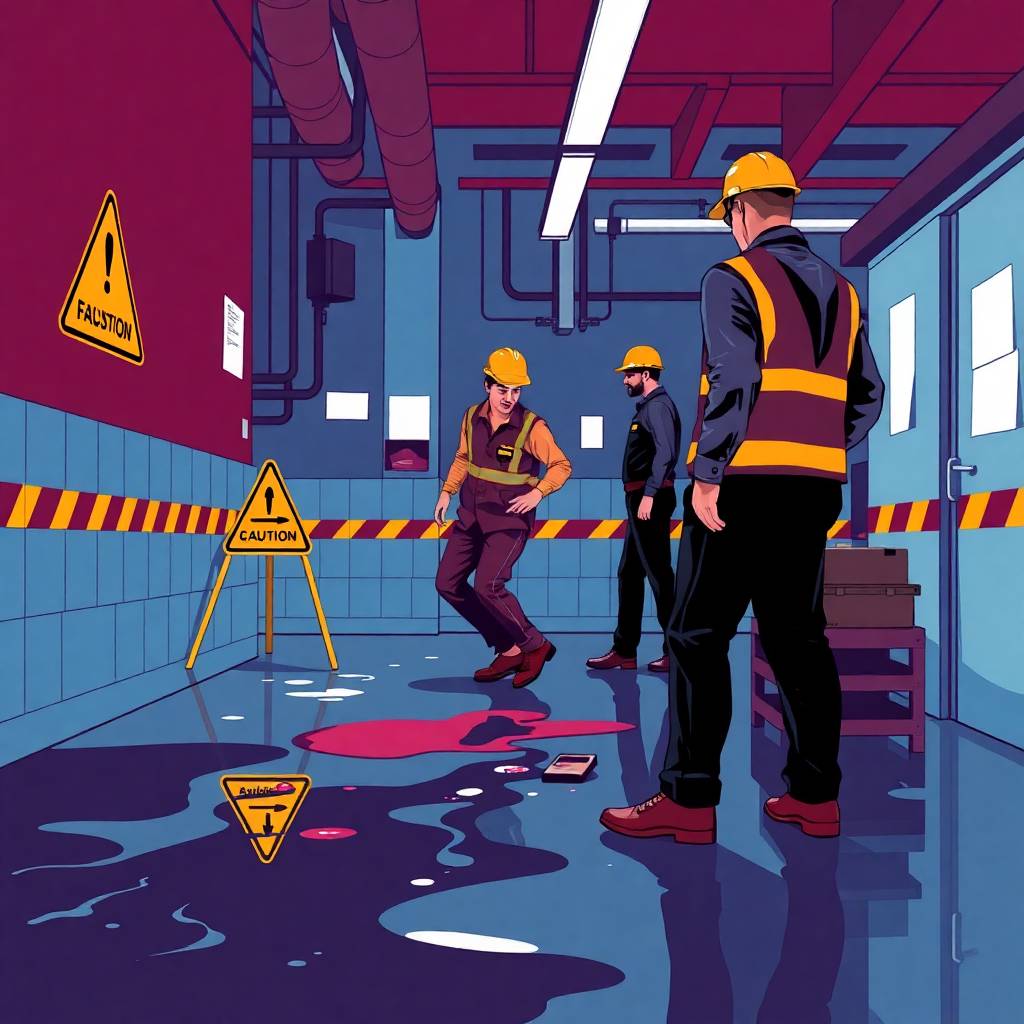Workplace hazards are not limited to construction sites or heavy machinery, so here’s some examples of hazards in the workplace. They exist in every industry, from healthcare to offices, and each type of hazard requires its own management approach. Safe Work Australia groups hazards into broad categories that cover both obvious and hidden risks.
1. Physical Hazards – Examples of Hazards in the Workplace
Physical hazards are the most immediately recognisable because they involve conditions in the environment that can cause direct injury. These risks are present in nearly every workplace, from warehouses and factories to offices and retail stores. When people think about examples of hazards in the workplace, physical hazards are usually the first that come to mind.

Slips, Trips, and Falls
Slips and trips occur when walking surfaces are uneven, wet, or cluttered. A small puddle of water, a loose cable across the floor, or poor housekeeping in a stockroom can all create risks. Falls can happen from ground level or from heights, with the latter often resulting in severe injury.
Controls: Regular inspections, immediate cleanup of spills, clear walkways, signage, and training workers to identify hazards before they cause accidents.
Noise Exposure
Loud machinery, tools, or even office equipment can create excessive noise levels. Prolonged exposure may lead to permanent hearing loss or fatigue, which affects productivity.
Controls: Install soundproofing or barriers, maintain equipment to reduce noise, and provide personal hearing protection where necessary. Conduct regular noise assessments to ensure compliance with exposure limits.
Vibration Hazards
Workers using jackhammers, chainsaws, or similar tools may be exposed to hand-arm vibration. Long-term exposure can lead to serious conditions such as vibration white finger or musculoskeletal disorders.
Controls: Limit exposure time, rotate tasks among workers, and use vibration-dampening equipment. Regular health checks can identify early signs of vibration-related injuries.
Working at Heights
Construction workers, maintenance staff, or even office employees changing light fittings may face risks when working above ground. Falls from heights are a leading cause of workplace fatalities in Australia.
Controls: Guardrails, harnesses, fall arrest systems, and training in safe work practices. Work at height should only occur when absolutely necessary, and controls should be rigorously enforced.
Extreme Temperatures
Heat stress is common in outdoor jobs such as construction, agriculture, or road work. Conversely, cold stress affects those working in refrigerated storage or outdoor winter environments.
Controls: Provide shade and hydration for hot conditions, warm protective clothing in cold environments, and adjust work schedules to avoid extreme conditions.
2. Chemical Hazards – Examples of Hazards in the Workplace
Chemical hazards are among the most underestimated workplace risks because they are not always visible. Unlike a trip hazard or an exposed edge, chemicals can cause harm through inhalation, skin contact, or even delayed health effects that appear months or years later. This makes them critical when discussing examples of hazards in the workplace, especially in industries like construction, healthcare, cleaning, and manufacturing.

Solvents, Glues, and Adhesives
Many industries rely on adhesives and solvents in daily operations. From printing presses to carpentry workshops, workers are regularly exposed to volatile organic compounds (VOCs) that can irritate the skin, eyes, and respiratory system. Long-term exposure may contribute to chronic illnesses.
Controls: Use low-VOC or water-based alternatives, ensure proper ventilation, and train workers on safe handling and disposal. Always store chemicals in clearly labelled containers.
Cleaning Chemicals
Hospitality, aged care, and office cleaning staff often use strong cleaning agents containing bleach, ammonia, or acids. Incorrect mixing of these substances can produce toxic gases, while prolonged skin contact may cause burns or dermatitis.
Controls: Provide training on correct dilution ratios, ensure workers wear gloves and eye protection, and install proper storage facilities. Safety Data Sheets (SDS) must be accessible at all times.
Paints, Fumes, and Sprays
Painting, coating, or spraying in confined or poorly ventilated spaces creates significant chemical exposure risks. These substances can cause dizziness, headaches, or even long-term neurological damage.
Controls: Use spray booths, enforce mask use, and rotate workers to minimise exposure. Proper ventilation systems are essential in enclosed areas.
Fuels, Oils, and Lubricants
Mechanics, transport workers, and machine operators often handle fuels and oils daily. While spills may seem minor, they create both fire and health hazards. Diesel fumes, in particular, are classified as a carcinogen.
Controls: Store fuels in approved containers, enforce spill management procedures, and provide training in fire safety. Ventilation systems should remove exhaust fumes effectively.
Hazardous Dusts: Asbestos and Silica
Construction and demolition workers face serious risks from asbestos fibres and silica dust. Both can cause long-term, irreversible lung diseases such as asbestosis, silicosis, and lung cancer. These are some of the most serious examples of hazards in the workplace because they often go unnoticed until too late.
Controls: Identify asbestos before work begins and engage licensed removalists. For silica, use water suppression methods, on-tool dust extraction, and enforce the use of respiratory protective equipment.
Agricultural Chemicals
Farmers and horticultural workers regularly use pesticides, herbicides, and fertilisers. Exposure can cause acute poisoning, skin irritation, or chronic health effects depending on the level and duration of contact.
Controls: Provide chemical handling training, ensure PPE is always available, and maintain proper record-keeping of chemical use. Storage facilities must comply with environmental regulations.
Why Chemical Hazards Matter for Businesses
Chemical hazards are particularly important because of their potential for both immediate accidents (such as chemical burns or poisoning) and long-term health conditions (like cancer or respiratory disease). Unlike some other categories, chemical hazards are highly regulated, and failure to manage them can result in significant fines, reputational damage, and worker compensation claims.
In every workplace where chemicals are present, from offices using cleaning products to industrial plants handling dangerous substances, examples of hazards in the workplace highlight the need for a structured hazard management plan.
3. Biological Hazards – Examples of Hazards in the Workplace
Biological hazards are risks that come from living organisms or materials produced by them. They often feel less visible than slips, falls, or chemicals, but they can have devastating health consequences. When exploring examples of hazards in the workplace, biological risks are especially relevant in healthcare, aged care, hospitality, food processing, agriculture, and education.

Viruses, Bacteria, and Fungi
Workplaces with close human contact, such as hospitals, childcare centres, or customer-facing roles, are particularly vulnerable to infectious diseases. The COVID-19 pandemic showed just how disruptive biological hazards can be, with transmission leading not only to illness but also to massive operational shutdowns.
Controls: Implement infection control procedures, encourage vaccination where appropriate, maintain proper ventilation, and provide PPE such as masks and gloves.
Blood and Bodily Fluids
In healthcare, first aid, and emergency response, exposure to blood or bodily fluids carries risks of contracting diseases like hepatitis or HIV. Even small cuts or accidental needle-stick injuries can present serious health issues.
Controls: Train staff in universal precautions, supply proper sharps disposal containers, and provide hepatitis B vaccinations for frontline staff. Strict cleaning protocols are essential after exposure.
Animal Waste, Bites, and Scratches
Agricultural, veterinary, and zoo workers face hazards from direct contact with animals. Animal waste can spread parasites and bacteria, while bites and scratches may lead to infection or long-term illness.
Controls: Use protective clothing, ensure hygiene protocols are followed, and provide workers with training in animal handling. Veterinary staff should also have appropriate vaccinations.
Mould and Damp Environments
In offices, schools, or rental properties, mould can grow in damp conditions. Workers exposed to mould spores may develop respiratory problems, allergies, or skin irritation. This is one of the less obvious but increasingly recognised examples of hazards in the workplace.
Controls: Fix leaks promptly, maintain ventilation systems, and conduct regular inspections of high-risk areas such as bathrooms and basements.
Insects, Pests, and Vector-Borne Hazards
Outdoor workers and those in agriculture may encounter stings, bites, or diseases carried by insects such as mosquitoes or ticks. In food industries, pests can spread contamination that threatens both workers and customers.
Controls: Provide insect repellent and protective clothing for outdoor workers, ensure pest management systems are in place, and maintain hygiene standards in food-handling areas.
Why Biological Hazards Are a Growing Concern
The globalisation of supply chains, rising food production, and the ongoing impact of pandemics make biological hazards an unavoidable part of modern workplaces. Unlike some risks, these hazards can spread beyond the workplace to families and communities, magnifying their impact.
For PCBUs, addressing biological risks is not just about compliance but about protecting both workers and the wider public. By documenting biological hazards in a hazard management plan, businesses can show regulators they take these risks as seriously as physical or chemical dangers.
4. Ergonomic Hazards – Examples of Hazards in the Workplace
Ergonomic hazards develop when work tasks, equipment, or environments are not designed to fit the worker. Unlike an accident from a fall or a chemical spill, ergonomic issues build slowly over time. They can cause musculoskeletal disorders (MSDs), repetitive strain injuries, and chronic pain, which are among the most common work-related health conditions worldwide. When listing examples of hazards in the workplace, ergonomic risks often get overlooked, yet they affect both office staff and manual labourers alike.

Poor Workstation Design
In offices, non-adjustable chairs, poorly placed monitors, or desks that are too high or low create strain on the back, neck, and shoulders. Prolonged computer use without ergonomic support often leads to repetitive strain injuries and eye strain.
Controls: Provide adjustable chairs and desks, monitor stands, and ergonomic keyboards. Conduct workstation assessments regularly to ensure proper posture and alignment.
Repetitive Movements
Jobs that involve constant repetition, such as typing, packaging, assembly line work, or scanning items at a checkout, can cause cumulative damage to muscles and tendons. This often manifests as carpal tunnel syndrome, tendonitis, or bursitis.
Controls: Rotate workers between tasks, design workflows that reduce unnecessary repetition, and allow regular breaks. Encourage stretching and micro-pauses during repetitive work.
Manual Handling of Heavy Loads
Lifting, carrying, pushing, or pulling heavy items is a leading cause of back injuries. Warehousing, construction, and healthcare roles frequently require staff to handle loads that exceed safe weight limits.
Controls: Provide lifting equipment such as trolleys or hoists, train staff in safe lifting techniques, and ensure team lifting protocols are enforced when loads are heavy or awkward.
Awkward Postures
Even if a load is not heavy, awkward postures such as twisting while lifting, reaching overhead, or kneeling for long periods increase injury risk. For example, mechanics working under vehicles or cleaners bending repeatedly may develop chronic musculoskeletal issues.
Controls: Redesign tasks to minimise bending and twisting, provide height-adjustable equipment, and ensure workers are trained to recognise unsafe postures.
Prolonged Sitting or Standing
Office staff sitting for hours or retail workers standing in one position for long shifts both face ergonomic risks. Prolonged inactivity can cause circulation problems, muscle fatigue, and increased risk of chronic health conditions.
Controls: Encourage sit-stand workstations, schedule regular breaks, and promote movement throughout the day. Provide anti-fatigue mats for staff required to stand for long shifts.
Why Ergonomic Hazards Are Costly
Unlike sudden injuries, ergonomic hazards often develop slowly, making them harder to detect and report early. By the time a worker seeks medical help, the condition may already be advanced, requiring long-term treatment or rehabilitation. This leads to high compensation costs and reduced productivity.
For businesses, proactively addressing ergonomic hazards is critical. Embedding them into hazard management plans shows regulators and workers that all risks, not just the dramatic ones, are being taken seriously. Among the most underestimated examples of hazards in the workplace, ergonomic risks deserve as much attention as physical or chemical dangers.
5. Psychosocial Hazards – Examples of Hazards in the Workplace
Psychosocial hazards are risks to mental health and wellbeing caused by the way work is organised, managed, or experienced. Unlike physical hazards that may cause immediate injury, psychosocial risks often build up quietly but can have serious consequences, from burnout and anxiety to long-term psychological injury claims. Safe Work Australia now requires PCBUs to manage psychosocial hazards with the same seriousness as physical risks, making this one of the most significant modern examples of hazards in the workplace.

High Job Demands
When workloads are excessive, deadlines unrealistic, or staffing levels inadequate, workers face constant pressure. High demands lead to stress, fatigue, and mistakes, which can create flow-on safety risks.
Controls: Monitor workloads, set achievable deadlines, ensure sufficient staffing, and provide access to support resources. Managers should regularly check in with employees to adjust demands where needed.
Low Job Control
When workers have little or no say in how or when they perform tasks, they may feel powerless and disengaged. Micromanagement, rigid rostering, and lack of autonomy are common contributors.
Controls: Involve workers in decision-making, provide flexibility in how tasks are completed, and trust staff to manage their responsibilities where possible.
Bullying, Harassment, and Conflict
Toxic behaviours such as intimidation, exclusion, harassment, or persistent conflict create hostile work environments. These psychosocial hazards can lead to severe mental health conditions and even physical illness.
Controls: Implement zero-tolerance policies for bullying, provide confidential reporting systems, and train managers in conflict resolution and respectful leadership.
Remote or Isolated Work
Working in isolation, whether in remote locations like mines and farms, or through modern remote working arrangements, can create feelings of disconnection, loneliness, and lack of access to immediate support.
Controls: Schedule regular check-ins, provide communication tools, and ensure remote workers are included in team meetings and development opportunities.
Poor Organisational Change Management
Major changes such as restructures, redundancies, or new technology often create uncertainty and stress if handled poorly. Workers who feel excluded from decision-making processes are more likely to disengage. This is one of the Examples of Hazards in the Workplace that can be helped by enhanced communication.
Controls: Communicate changes early and openly, involve staff in planning, and provide support during transitions.
Lack of Support from Supervisors
Managers who fail to provide clear instructions, feedback, or emotional support increase psychosocial risks. Workers left “in the dark” about their role or without backup during stressful times experience greater strain.
Controls: Train managers in supportive leadership, hold regular one-on-one discussions, and encourage open communication channels between staff and supervisors.
Why Psychosocial Hazards Matter for Businesses
Psychosocial risks are now among the fastest-growing causes of workplace injury claims. They often result in longer absences and higher costs than physical injuries. Beyond compliance, failing to manage these hazards damages workplace culture, increases turnover, and undermines productivity.
By documenting psychosocial risks in a hazard management plan, businesses demonstrate that they understand the full scope of workplace safety obligations. For modern workplaces, examples of hazards in the workplace must extend beyond slips and chemicals to include the psychological and social aspects of work.
6. Environmental Hazards – Examples of Hazards in the Workplace
Environmental hazards arise from conditions in the physical environment that increase risks to health and safety. Some are external forces beyond an employer’s direct control, while others result from poor workplace design or maintenance. Because they cut across all industries, from construction to offices, they are a critical part of any guide to examples of hazards in the workplace.

Poor Lighting
Inadequate lighting makes it difficult for workers to see properly, which increases the risk of slips, trips, and errors. Warehouses, car parks, stairwells, and offices with insufficient natural or artificial light can all create hazards.
Controls: Conduct lighting assessments, install brighter bulbs in dim areas, and ensure emergency exit lighting is always operational. For computer-heavy offices, balance natural and artificial lighting to reduce eye strain.
Inadequate Ventilation
Confined spaces and poorly ventilated rooms can accumulate dust, fumes, or lack of oxygen, creating risks of headaches, respiratory illness, or even suffocation. In some industries, such as food production or manufacturing, poor ventilation also contributes to chemical or biological exposure. This is one of the Examples of Hazards in the Workplace that need a bit of extra infrastructure.
Controls: Install proper HVAC systems, maintain filters, and ensure regular testing of confined spaces before entry. Workers must be trained in safe confined-space entry procedures.
Outdoor Exposure to UV Radiation
Outdoor workers such as construction staff, agricultural labourers, or delivery drivers face prolonged exposure to the sun. Over time, UV radiation significantly increases the risk of skin cancer, which is one of the most common occupational diseases in Australia.
Controls: Enforce sun protection policies, provide shaded rest areas, supply sunscreen, hats, and protective clothing, and rotate shifts to minimise exposure during peak UV hours.
Natural Disasters and Extreme Weather
Bushfires, floods, storms, and heatwaves are becoming more frequent due to climate change. These events can disrupt operations, damage property, and put workers at direct risk of harm.
Controls: Develop and practise emergency evacuation plans, provide fire-resistant or flood-safe equipment where relevant, and keep workers informed through weather alerts. Employers should also plan for business continuity during extreme events.
Air Quality and Pollution
Workers in urban areas, industrial zones, or near major construction projects may be exposed to high levels of dust, smoke, or exhaust fumes. Poor indoor air quality can also reduce productivity and contribute to illness. This is one of the Examples of Hazards in the Workplace that may not always be as obvious and may require testing.
Controls: Monitor air quality levels, install air filtration systems, provide respiratory protection if necessary, and limit outdoor work during high-pollution days.
Why Environmental Hazards Must Not Be Overlooked
Environmental hazards often seem beyond the control of individual workplaces, but PCBUs still have a duty to prepare and protect workers. From something as simple as better lighting to complex emergency planning for natural disasters, these risks must be documented and controlled.
When building a complete hazard management plan, including environmental risks alongside physical, chemical, biological, ergonomic, and psychosocial ones ensures that the business covers every category. Without this, the list of examples of hazards in the workplace remains incomplete, leaving gaps that regulators or auditors may identify during inspections.
Why These Examples Matter
Understanding the different types of hazards is the first step in controlling them. A workplace that only looks for “obvious” physical hazards may miss psychosocial or ergonomic issues that can be just as damaging. A good hazard management plan captures all categories of hazards, assigns risk ratings, and sets out clear controls.
How to Identify Hazards in the Workplace
Identifying hazards is the first step in controlling them. Examples of hazards in the workplace can often be controlled, so here’s some strategies. Businesses can use multiple strategies:
- Workplace inspections – regular walk-throughs to observe conditions.
- Worker consultation – staff often spot hazards managers overlook.
- Incident reports – past near misses and accidents reveal ongoing risks.
- Surveys and checklists – structured tools that capture hidden or less obvious hazards.
- Specialist assessments – e.g., noise testing, ergonomic reviews, or chemical exposure monitoring.
When assessing examples of hazards in the workplace, it’s important to consider not just what has already caused incidents but also what could cause harm if left unmanaged.
Benefits of Identifying Workplace Hazards
We’ve explored a range of Examples of Hazards in the Workplace, now its time to review the management of these hazards. Taking a systematic approach to hazard management offers clear benefits:
- Reduced incidents and claims – fewer injuries, illnesses, and workers’ compensation costs.
- Improved compliance – evidence of hazard management satisfies WHS regulators.
- Higher worker confidence – staff feel safer and more engaged when risks are addressed.
- Increased productivity – safe workplaces run more smoothly with fewer disruptions.
- Stronger safety culture – hazard management becomes part of everyday work.
Examples of Hazards in the Workplace: Quick Reference Table
| Hazard Type | Examples of Hazards in the Workplace | Control Measures |
|---|---|---|
| Physical | Slips, trips, falls, noise, vibration, heights, temperature extremes | Guardrails, PPE, maintenance, inspections |
| Chemical | Solvents, cleaning products, paint fumes, fuels, asbestos, pesticides | Ventilation, substitution, PPE, safe storage |
| Biological | Viruses, blood, animal waste, mould, pests | Hygiene protocols, vaccination, protective clothing |
| Ergonomic | Poor workstation design, repetitive movements, heavy lifting, awkward postures, prolonged sitting | Ergonomic equipment, task rotation, training |
| Psychosocial | High job demands, bullying, low support, isolation, poor change management | Supportive leadership, policies, worker consultation |
| Environmental | Poor lighting, inadequate ventilation, UV exposure, extreme weather, air pollution | Lighting upgrades, HVAC, sun safety, emergency plans |
This table can be included in hazard management plans, induction training, or safety committee meetings as a quick reminder of the main examples of hazards in the workplace.
FAQs: Examples of Hazards in the Workplace
Q: What are the 6 types of hazards in the workplace?
The six categories are physical, chemical, biological, ergonomic, psychosocial, and environmental.
Q: What’s the difference between a hazard and a risk?
A hazard is the source of potential harm, while a risk is the likelihood and consequence of that harm occurring.
Q: Why are psychosocial hazards included?
Since 2023, WHS laws require employers to manage psychosocial risks such as bullying, high workloads, and low job control, recognising them as legitimate workplace hazards.
Q: Do small businesses need to manage all hazards?
Yes. PCBUs of all sizes are legally required to identify and control workplace hazards, though the level of documentation may differ.
Q: How can businesses stay on top of hazards?
Use a structured hazard management plan template to record, assess, control, and review hazards regularly.
Using Examples of Hazards in the Workplace to Create Safer Workplaces
Identifying hazards is the first and most important step toward creating safer workplaces. By looking beyond the obvious and considering all six categories, employers can build a complete picture of the risks their workers face.
Understanding examples of hazards in the workplace helps businesses go from reactive to proactive. It prevents accidents, improves compliance, boosts worker confidence, and builds stronger organisational resilience.
📌 For businesses ready to put this knowledge into practice, a structured Hazard Management Plan Template Package from SaferOutcomes makes it easy to document hazards, assign controls, and stay audit-ready. Don’t just know the hazards, manage them.